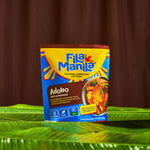

What is Chicken Adobo? The Philippines’ National Dish, Explained
From Philippines to Fila Manila
By Patrick Kho, for Fila Manila
Savory, tangy, with a rich dark brown sauce coating tender, slow-cooked chicken. What is it? It’s the Philippines’ national dish, Chicken Adobo — a perfect medley of salty, sour, and umami flavors.
What is Adobo?
To break it down simply, adobo is a Filipino dish. Adobo is made by stewing meat, seafood or vegetables in a mix of soy sauce, vinegar, and garlic.

Once a beloved staple in Filipino and Filipino American homes, Chicken Adobo has now gained widespread internet popularity. Today, even non-Filipino food creators like @milktpapi on TikTok and Joshua Weissman on YouTube often make the dish on their platforms. By sharing this Filipino dish with a wider audience, they’ve helped bring it into the mainstream.
In its most common form, adobo is cooked using chicken, usually drumsticks or thighs, to make Chicken Adobo. But it can also be cooked with pork, and some variations in the Philippines also cook the dish with seafood, like squid.
History of Adobo: How the Chicken Adobo Became a Filipino Symbol
Like many cultures in warm climates, indigenous Filipinos developed different cooking methods to preserve food. The most common included boiling and braising, and to keep their food fresher for a longer period, dishes were prepared with plenty of vinegar and salt to prevent bacteria growth. This was adobo at its earliest form: meats stewed in salt and vinegar for preservation.
Eventually, Chinese traders brought soy sauce to the nation, and Filipinos began incorporating the ingredient into the dish as a predominant flavor, displacing salt altogether. When the Spanish Empire arrived in the Philippines in the 16th century, the name “adobo” was assigned to the indigenous cooking technique, from the Spanish word “adobar” (which means “to marinate”).

Read more: A Brief History of Filipino Adobo
Adobo continued to remain a key part of the Philippines’ cuisine throughout the centuries that followed, but the dish’s synonymy with the Philippines and Filipino identity began when FIlipinos started migrating internationally for work.
“Filipino immigrants … say that the dish they often miss the most and make when away from home is chicken adobo,” writes Mariel Gonzalez of The University of Toronto. And really, all you need to make chicken adobo is chicken, soy sauce, vinegar, garlic, and pepper — all ingredients that Filipino immigrants could find in their countries of destination. Combining ease and convenience with the memories of home that adobo elicited, adobo became the most commonly cooked dish among a Filipino population spread across the world.
As Filipinos continued to become one of the most diasporic populations, Filipino food became more widely recognized. And adobo, the dish of the Filipino diaspora, soon became synonymous with the Philippines.
Adobo Recipe: The Simplest Method of Making Chicken Adobo
Chicken Adobo is an easy dish to make. But we’ve got the most simple 4-step recipe on the internet:
- In a pot, sear your chicken until it’s golden brown.
- Pour in your Fila Manila Adobo Simmer Sauce.
- Add your chosen aromatics and vegetables to the pot — we recommend bay leaves and potatoes.
- Simmer until chicken is cooked and sauce thickens.
And there you have it! Chicken Adobo in four easy steps. Read our full recipe for delicious instant adobo here.
Beyond your traditional Filipino Chicken Adobo, the adobo flavor’s medley of salty, sour, and umami works great in many other dishes too:
-
Adobo Breakfast Fried Rice, a great way to turn leftover adobo into a savory start to your day.

-
Adobo Tacos, a Filipino-Mexican fusion dish that pairs chicken adobo with tortillas instead of white rice.

-
Mushroom Adobo, a simple vegan and vegetarian alternative to Chicken Adobo, inspired by the popular dish at the Kasama Restaurant in Chicago (the first Michelin-starred Filipino restaurant!).

-
Adobo Chocolate Chip Cookies (yes, you read that right!), a fun, Filipino twist on the classic sweet treat.

The Different Kinds of Adobo
Other countries also have their own kind of “Adobo.” In Spain, for example, adobo is a dish where food is immersed in a sauce of vinegar and different spices — such as paprika, oregano, and garlic — to enhance its flavor.
This variation is common in other countries previously colonized by Spain, such as Mexico, Peru, and Uruguay. In these countries, adobo is more spicy than in the Philippines (in comparison. Filipino adobo is more salty and sour).
Read more: Filipino Adobo vs. Spanish Adobo — what’s the difference?
But even in the Philippines, there are many different ways to cook adobo. While the most popular variation of the dish is made using soy sauce, vinegar, and garlic, and with chicken or pork as the main proteins, other versions also exist. These include:
-
Adobo sa Gata — meaning “adobo in coconut milk.” Adding this extra ingredient to the braising liquid is popular in the Philippines’ Bicol region.

- White Adobo — replacing the soy sauce with salt for a less dark sauce.
- Crispy Adobo — deep frying leftover chicken and pork adobo to create an entirely new dish!
-
Chinese Adobo — adding star anise and sugar to the braise, for a flavor similar to the Chinese dish hong shao rou.

There are endless ways to cook adobo — even in its most basic form, the kinds of vinegar or soy sauce used can have a real effect on the dish’s flavor.
Some families add their own special ingredients to the braise. Fila Manila founder Jake Deleon’s family adds date nectar to their adobo, for a more nuanced, sweet taste.

Such variety partly explains why adobo is so loved around the world. The dish can be easily adjusted to taste, in such a way where there is an adobo for everyone!
Common Adobo Questions — We’re Here to Answer
What is the best cut of chicken for Chicken Adobo?
Thighs, drumsticks, and wings are better cuts for Chicken Adobo because they’re fattier, which makes them more flavorful. Since adobo is a stewed dish that cooks for a while, cuts with more bones, like thighs and drumsticks, offer more depth of flavor compared to breast meat.
Can I make Chicken Adobo without soy sauce?
As mentioned earlier, there are many ways to make Filipino adobo. You can make adobo without soy sauce. This would be more similar to adobong puti, the variation which replaces soy sauce with salt, and is much similar to the pre-colonial versions of adobo.
What type of vinegar is best for Chicken Adobo?
The most traditional Filipino recipes use cane or coconut vinegar. But you can also use…
- Chinese Black Vinegar: for a lingering sweetness, darker color, and more Chinese-style flavor.
- Rice Vinegar: for a sweeter adobo flavor.
- White Vinegar: for a more sour adobo flavor.
- Apple Cider Vinegar: if there isn’t any other kind of vinegar, using this can be great for gut health!
At the end of the day, the kind of vinegar you choose really depends on the kind of flavor you’re looking for in your adobo.
How long should I simmer the chicken for Adobo?
If you’re using a more traditional recipe, the recommended braising time will depend on the cut of chicken you are using. This recipe by pepper suggests simmering your chicken for 1 hour and 30 minutes.
However, if you're using Fila Manila’s Adobo Sauce, you can expect a shorter cooking time, since much of the adobo flavoring is already concentrated in the sauce. Read our full adobo recipe here.
Can I freeze Chicken Adobo?
Yes, you can. Frozen Chicken Adobo can last for up to two months. This long shelf life is in part because adobo is made with vinegar and soy sauce, which help preserve the dish.
Additionally, because adobo is a stew, storing it in either the freezer or refrigerator allows the flavors to further mix and intensify. In many Filipino households, it’s common to eat adobo the day after it’s made, as the extended resting time enhances the taste.
What can I serve with Chicken Adobo?
We recommend eating your Chicken Adobo with white rice and a hard-boiled egg.
How can I make adobo fast?
With Fila Manila’s Adobo Marinade & Sauce, you can make adobo in less than 30 minutes. Read our full recipe here.
Sources:







